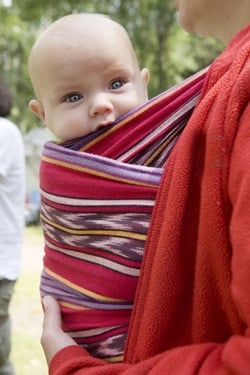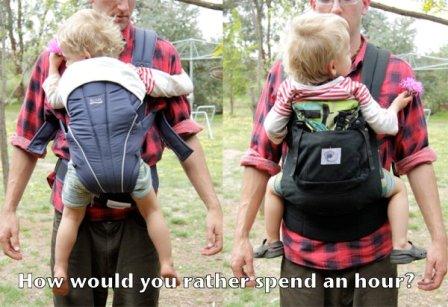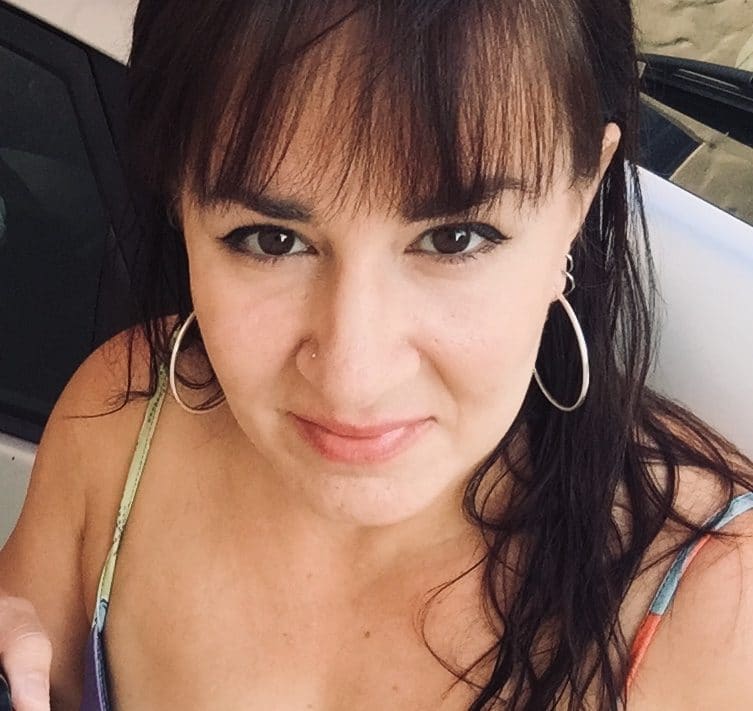Being an eco-conscious parent often means taking a look at the footprint of all the baby gear we are told we just have to own in order to properly raise our children.
Sometimes this means finding greener choices (like cloth diapers instead of disposables). Sometimes this means using hand-me-down onesies from your older sister, and sometimes this means opting out altogether from purchasing things that will become quickly obsolete.
Are Strollers Necessary?
When reducing your “baby footprint,” consider whether or not you really need a fancy stroller. Strollers are expensive, use a lot of fossil fuel resources and generate a lot of toxic waste from manufacture, to packaging and shipment to your local store, all the way to their final resting place in the landfill after they inevitably wear out.
Not only do strollers have a large ecological footprint from cradle to grave, but they may not be very good for your child’s development either. Studies 1 have shown that strollers in which your baby faces away from you could risk long-term development problems in your children.
Better for Baby, Better for Mom and Dad

For most of human history, there have been no strollers, nor any heavy “baby bucket” carseats to lug around. Even today, most of the world’s parents use cloth wraps of various types to wear their babies on their bodies. In the last couple of years, many Americans and Europeans have returned to the practice too.
Studies have shown that babywearing has many benefits for infants and young children as well as for the carrying parent. Here are five of them:
1. Babies who are carried often cry less.
A 1986 randomized, controlled study 2 by Hunziker and Barr showed that carrying an infant 2 additional hours per day reduced crying overall by 43%, or one entire hour.
2. Babywearing is good for babies physically.
According to Dr. Eckhard Bonnet in an article published on Didymos 3, a baby wrap or sling holds a baby’s body in a comfortable, correct position, much as the womb carries a fetus before birth.
Upright carrying also massages your baby’s abdomen which promotes healthy digestion, and prevents physical abnormalities associated with infants who spend large amounts of time lying on their backs or bellies (such as hip dysplasia, frog legs, or flattened skulls on the back or sides).
Note: The exception to this are the baby carriers that dangle your baby from his crotch. These facing-out types of carriers are harmful to the development of your child’s hips. See below.
3. Babywearing encourages healthy mental and emotional development.
Since in-arms parenting meets your baby’s needs for warmth, comfort, and access to breastfeeding, babies cry less and spend more time in a quiet, alert state. While in this state they are better able to learn about their environment and develop mentally and socially 4.
As long as you can carry them, toddlers also enjoy being worn, and benefit greatly from interacting with others at eye-level instead of being looked down upon in a stroller.
4. Babywearing makes parenting easier.
Carrying baby in a sling, wrap or pack frees your hands to work, or assist in the needs of older children while still being able to give your baby the closeness she needs. Many slings also allow for breastfeeding while on the go.
If yours is the type of baby that needs to be held during naps, doing it with a baby carrier allows you to get some work done, or to do almost any other activity.
5. Babywearing promotes attachment.
Babywearing allows you to bond with your baby and learn to meet your child’s needs more quickly. Babywearing also helps mothers who may be suffering from depression to nurture their babies with less effort. Preemies and sick infants also grow and heal faster when worn, especially when the baby and parent are skin-to-skin. This is sometimes called “kangaroo care,” and is increasingly practiced in hospital neonatal intensive care units.
No wonder more and more Western parents are babywearing these days! It should be no surprise that what has worked for parents for thousands of years works just as well when adapted for modern times!
How to Choose a Good Baby Carrier

There are many types of slings and carriers available to meet a variety of needs and preferences. Some of them are beautiful works of fashion art any new mom would love to wear, and there are gender-neutral carriers for Dad, too.
A good baby carrier mimics the way you would naturally hold your baby—either cradled in your arms, straddling your hip, or piggy-backed. According to Dr. Eveline Kirkilionis at the Hip Dysplasia Institute, you should look for the following criteria when selecting a baby carrier:
1. Fabric
Your first consideration should be how the carrier was manufactured and what materials were used. Look for non-toxic dyes and materials that weren’t treated with flame retardants or other textile chemicals. Your baby will spend a lot of time close to, or even chewing, the fabric.
2. Leg Position
The legs should be at least pulled up to a 90 degree angle and supported behind the leg. This is only possible if the baby sling crotch piece is wide enough so that it will reach to the back of your baby’s knees.
3. Back Support
The back of the carrier needs to support the baby’s back, so that he or she is not slouching excessively while in the upright position. It needs to be supportive enough that even when your baby is asleep his/her body is tightly secured to your body.
4. Headrest
The back of the carrier needs to reach over the baby’s head, on all three sides, to keep the head from falling backwards or sideways. This is very important as long as the infant can’t keep his/her head up. As your child grows larger, this is important only when he or she takes a nap. Make sure the head rest is sturdy and doesn’t fold back when pushing on it with your hand.
5. Shoulder Support
Carriers supported by both shoulders with wide straps are best to prevent back problems for yourself. Carriers that are only supported by one shoulder often worsen the slight scoliosis that most people have.
6. Growth
Your baby is growing fast. Most baby slings are outgrown by 3-9 months. Choose one that will grow with your child.
7. Adjustability
Pick a carrier that can be adjusted to you and your baby’s needs. Babies carried too low experience pressure pushing their legs back with every step you take (putting too much strain on the hip joints and encouraging hip dysplasia.)
A carrier that adjusts well can also be used by multiple adults in the family who might have different heights and weights.
8. Facing in
Only choose a baby carrier that allows your child to face you—never out. Not only does a child need support to hold the leg in a 90 degree angle, but when facing out, a baby has no way to exclude himself from a busy or overstimulating environment by turning his head away and towards you. Healthy sleep is difficult for a baby who is facing outward.
9. Heat
Many carriers are made of Nylon. Find one that allows airflow to reach your baby. Any non-breathable fabric will encourage a rash on your baby’s skin when being carried in hot weather or for an extensive period of time.
10. Hips
When carrying the baby in an upright position, the baby’s hips should always be straddled around your body. The legs should be pulled up at least to a 90 degree angle. When the baby’s knees are pulled up to a 90 degree angle, the baby’s legs are spread between 90 and 120 degree angle around the wearer’s body. This agrees with the baby’s anatomical make up and supports proper hip development.
Some Baby Carriers are Dangerous!

Some popular front packs have narrow seats that encourage bad positioning for your baby, and can even cause hip dysplasia, scoliosis 5 or spondylolisthesis 6 with prolonged use.
Sometimes disparaged as “baby-danglers,” front packs with narrow seat areas essentially place your baby’s body weight on his or her crotch (instead of being in the desirable “frog” position), which is very unnatural and extremely uncomfortable, and can damage a baby boy’s developing scrotum.
Dangling legs also encourage the ball of the femur out of the hip socket with every stride you take, fostering dysplasia.
Front packs also dangle baby in a position that pulls their weight down and away from you. This throws off your center of balance and means you subconsciously compensate by leaning back a little, which can quickly lead to back strain and discomfort.
The straps of these types of front packs are also often thin, digging into your shoulders and back, and few brands use a waist belt, which would take some of the weight off of your shoulders.
For all these reasons, front packs tend to get very uncomfortable after your baby gets to be about 4 months old. For the amount of money you pay for a “baby-dangling” front pack, you would be better advised to invest in a decent baby carrier that you will get years of use from that will be comfortable and safe for you AND your baby.
Where to Find a Baby Carrier
Safe, quality baby carriers can increasingly be purchased at retail stores, but you can find a much better selection online. Good brands include Ergobaby, Baby Tula, Boba, Beco Baby, and Wildbird, but there are many great carriers out there. There are also many Facebook groups, forums and local clubs dedicated to babywearing that can help you get started.
So, unless you are unable to carry your child on your body (and there are many reasons why this may be so), why not enjoy all the ecological, developmental and practical benefits of wearing your baby? You could save between $200-$700 by not buying that stroller, and feel great about preventing all the pollution and loss of natural resources that goes into producing, packaging, shipping and disposing of them.
Plus, babies instantly dress up even the most frumpy wardrobe.
Recommended Baby Carriers
Sources
- https://app.dundee.ac.uk/pressreleases/2008/prnov08/babybuggies.htm
- Hunziker UA, Barr RG. Increased carrying reduces infant crying: a randomized controlled trial. Pediatrics. 1986 May;77(5):641-8. PMID: 3517799. https://pubmed.ncbi.nlm.nih.gov/3517799/
- Carrying of infants and small children. Dr. Eckhard Bonnet, Didymos, 1998. https://www.didymos.de/media/6a/82/96/1630588681/11_EN_Expertentexte-carrying%20small%20children.pdf
- Experiences with “Babywearing”: Trendy parenting gear or a developmentally attuned parenting tool? Lela Rankin Williams, Patricia R. Turner. Children and Youth Services Review, 2020. https://doi.org/10.1016/j.childyouth.2020.104918
- Baby Carriers and Other Equipment – IHDI Educational Statement https://hipdysplasia.org/baby-carriers-other-equipment/
- Infant Carriers and Spinal Stress. Rochelle L. Casses, D.C. 1996. https://continuumconcept.org/articles/spinal-stress













21 thoughts on “The Benefits of Babywearing (and How to Choose a Baby Carrier)”